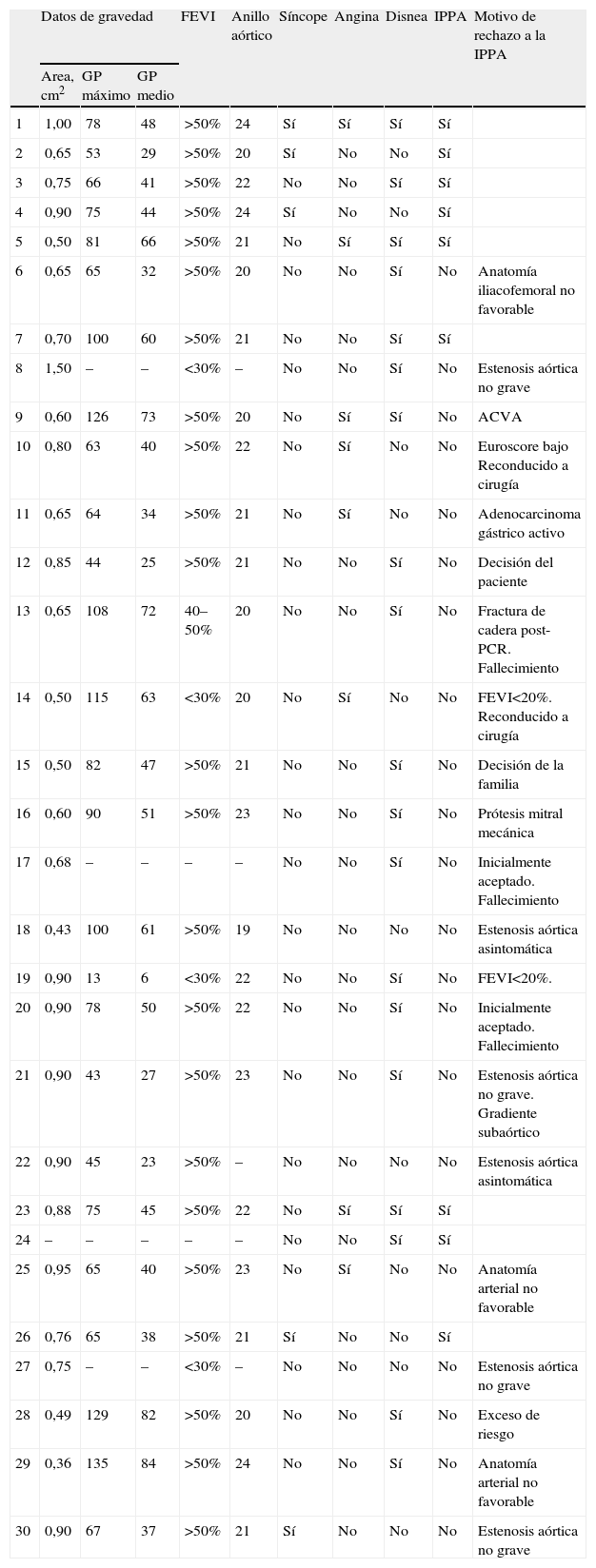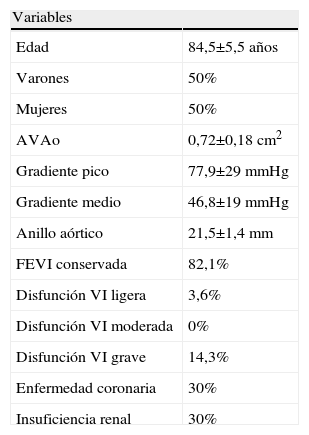En los últimos años se han desarrollado técnicas para la implantación de prótesis aórticas a través de catéter como alternativa terapeútica en pacientes con estenosis aórtica (EA) grave (EAG) rechazados para cirugía. Uno de los aspectos más complejos de este tratamiento es la selección correcta de los pacientes. El objetivo de este trabajo fue analizar cuál es la tasa de aceptación en nuestro centro para la implantación percutánea de prótesis aórticas (IPPA) entre aquellos pacientes presentados como posibles candidatos a la técnica, y evaluar cuáles son los motivos de exclusión para ésta.
Pacientes y métodoLa población de estudio la constituyeron 30 pacientes diagnosticados de EAG y rechazados para cirugía de recambio valvular a los que se remitió para valoración de IPPA. Los pacientes recibieron una detallada evaluación clínica, ecocardiográfica, angiográfica y mediante tomografía computarizada.
ResultadosDe los 30 pacientes, se rechazó para la técnica a 18 pacientes (60%): 4 tenían EA no grave, 2 se encontraban asintomáticos, en 2 se reconsideró la cirugía y finalmente se los operó, 5 tenían contraindicaciones para el procedimiento, a 3 se los rechazó por problemas de acceso vascular y otros 2 decidieron no realizarse el procedimiento tras informarse sobre éste. De 12 pacientes a los que finalmente se aceptó, 3 fallecieron antes de la realización del procedimiento. Por tanto, sólo 9 finalmente recibieron IPPA (30%).
ConclusionesEntre los pacientes remitidos para la realización de una IPPA, sólo se aceptó al 40% finalmente para ésta. La mortalidad durante la evaluación para esta técnica es elevada y pone de manifiesto el carácter terminal de estos pacientes.
In recent years, techniques for implantation of aortic prosthesis via catheter have been developed as a therapeutic alternative in patients with severe aortic stenosis rejected for surgery. The correct selection of candidates is one of the more complex aspects of this treatment. We analyzed the acceptance rate in our environment for transcatheter aortic valve implantation in patients referred to our hospital for evaluation as possible candidates, describing the exclusion reasons.
Patients and method30 patients with severe aortic stenosis and rejected for surgical aortic valve replacement were referred to our hospital to evaluate transcatheter aortic valve implantation. The patients first underwent clinical evaluation and were studied with echocardiography, angiography and computed tomography.
ResultsOf the 30 patients, 18 were rejected for the procedure (60%): 4 patients with non-severe aortic stenosis, 2 asymptomatic patients, 2 patients who finally underwent surgery because of a low-surgical-risk, 5 patients with contraindications for the procedure, 2 patients who finally did not want to undergo the procedure and 3 patients were further rejected because the vascular access was inappropriate. Of the remaining 12 patients initially accepted, 3 died before the procedure was performed. Finally, only 9 patients (30%) underwent transcatheter aortic valve implantation.
ConclusionsOf the patients referred for transcatheter aortic valve implantation, only 40% were accepted. The mortality rate during the evaluation process of this procedure is high, showing that these patients are terminally ill.
Artículo
Comprando el artículo el PDF del mismo podrá ser descargado
Precio 19,34 €
Comprar ahora











